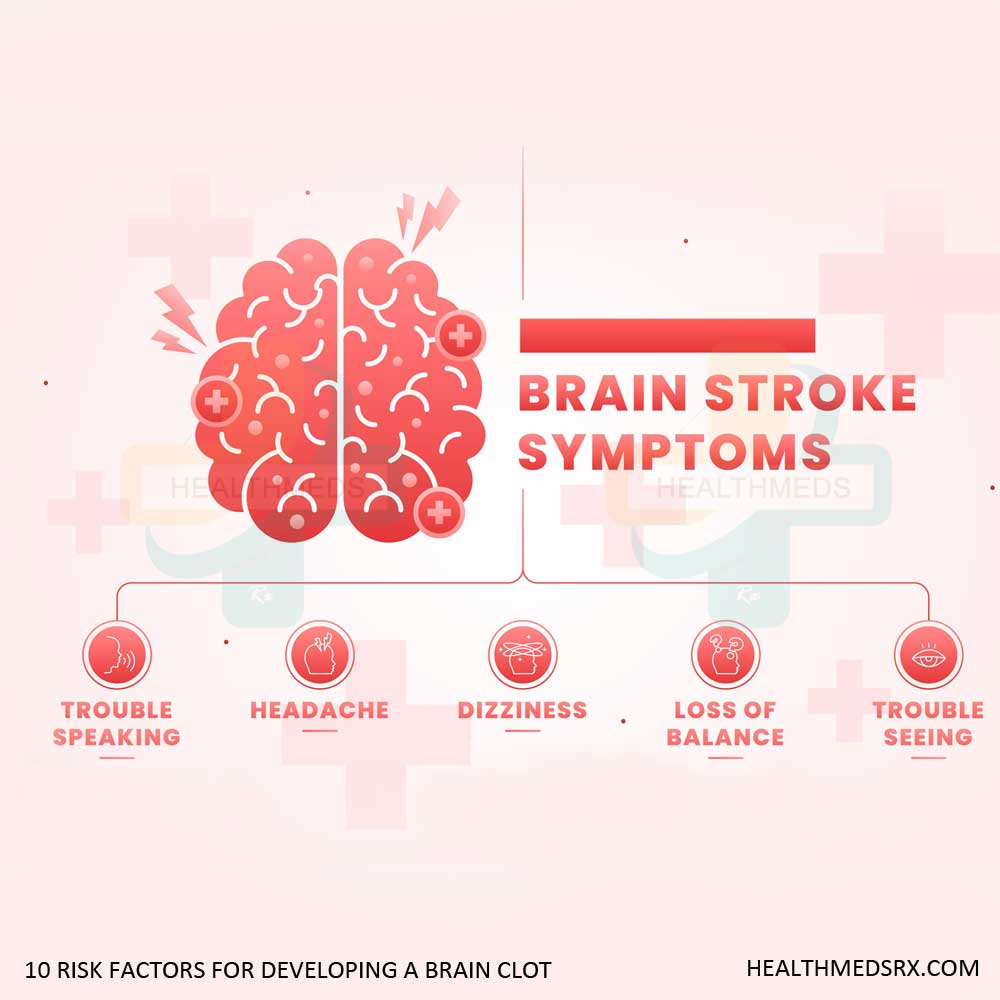10 Risk Factors for Developing a Brain Clot

A brain clot, also known as cerebral thrombosis, is a severe medical condition that can lead to life-threatening consequences such as stroke. It occurs when a blood clot obstructs blood flow to the brain, potentially causing irreversible damage. While awareness about strokes is rising, many people remain unaware of the risk factors that contribute to brain clots. This blog explores the lesser-known aspects of brain clots, emphasizing prevention and early detection to mitigate the risks.
What Is a Brain Clot?
A brain clot is a blockage in the blood vessels supplying the brain, most often caused by a blood clot forming in or traveling to the brain. These clots can lead to ischemic strokes; these are the most common type of strokes, and they make up 87% of all global cases as estimated by the World Stroke Organization. Brain clots can also occur because of hemorrhagic strokes where blood vessels in the brain burst and then release blood which worsens the effects. The circulation of blood, cholesterol levels, and heredity greatly cause the construction of clots.
The Role of Risk factors in brain clots
Known risk factors play a critical role in determining one’s risk of a clot in the brain. While some risk factors cannot be changed, for instance age, or genetic makeup, other risk factors can be controlled to some extent to ultimately reduce the risk factor. Awareness of these factors is important within the process of cause finding and the application of preventive measures. Three and still going on factors that are independent of consumer’s control could be primary causes of brain clots whereas the rest depend on various aspects that consumers could control to various extents in varying situations.
The 10 Risk Factors for Developing a Brain Clot
- Hypertension: Is the number one cause of strokes because it adds extensive pressure on the walls of blood vessels thus encouraging the formation of clots. According to the CDC, the investigators found out that approximately 29.2 percent of the adult population in the U.S. has high blood pressure, but many cannot tell.
- Smoking Tobacco: Smoke is dangerous to the blood vessels causing them to become prone to clotting. But even exposure to second hand smoke modifies the risk by 20-30% especially according to the American Heart Association.
- High levels of cholesterol: Cholesterol deposits on the artery walls narrow down blood vessels. This condition, known as atherosclerosis, is a precursor to clot formation, and a dangerous pattern can develop rather quickly. High cholesterol research reveals that LDL cholesterol provides the greatest level of risk. Therefore, maintaining proper cholesterol levels is very important.
- Diabetes: High levels of glucose in the bloodstream affect the blood vessels causing early formation of clots. Even though diabetic patients are not very numerous, they are 1.5 times more likely to have a stroke than the normal population as reported by the National Institute of Diabetes.
- Overweight and Physical Inactivity: We know overweight increases blood pressure, cholesterol, and diabetes—now we add them as triple-threat offenders in clot production. Sitting down also contributes to the problem by reducing blood flow and thereby raising the risk of blood clots and pooling.
- Family History & Genetics: Genetic standards for coagulation including the Factor V Leiden mutation bring the dangers of clotting more close to you. If a person has a history of stroke or blood clotting disorders, the probability of getting it also increases by 30% to 50%, according to the research done by Scientists at Nature Genetics.
- Hormonal Change: Among women there is an increased risk if they are on hormonal pills for birth control or for hormone replacement treatment for instance the result is due to high estrogen levels. Also, pregnancy and arterial blood clots tend to be higher because of changes in blood pressure and blood flow, highest in the period immediately after childbirth.
- Atrial Fibrillation and Heart Diseases: Irregular heart rhythms, such as atrial fibrillation (AFib), can cause blood to pool and clot in the heart, leading to strokes. AFib increases stroke risk by five times, as reported by the American Stroke Association.
- Old age and Gender: The vessels are weaker and blood circulation is relatively slow in the older generation, especially the older women. Notably, despite having a higher stroke frequency in men, women – or rather, postmenopausal women, have less favorable outcomes thanks to hormonal and physiological differences.
- Medical & Some diseases: Such as lung disease, heart disease, stroke, diabetes, autoimmune disease, and cancer, raise your chances of clots. Other diseases that increase the risk of clot formation include autoimmune diseases such as lupus because of persistent inflammation.
Signs and Symptoms of a Brain Clot
- Identifying the early warning signs of a brain clot is critical to preventing severe outcomes. Common symptoms include:
- Sudden numbness or weakness, especially on one side of the body.
- Difficulty speaking or understanding speech.
- Sharp pain in or around the eye, particularly when light hurts the eyes, or discomfort that worsens with tearing or discharge.
- A headache where its origin cannot be ascertained.
- Slightly’ to include the symptoms of loss of balance, dizziness, or coordination issues.
- Because of these symptoms, the patients should be taken to the hospital as early as possible to increase the chances of being treated.
Prevention and Risk Reduction of Brain Clots
Preventing brain clots involves a combination of lifestyle modifications and medical interventions:
- Adopt a Healthy Lifestyle: Exercise five times a week, consume a depleted diet containing fruits, vegetables, and omega-3 fatty acids, and stop smoking.
- Monitor Health Conditions: Have a check on blood pressure, cholesterol, and diabetes often.
- Medications: Take anticoagulants or blood thinners only when advised to do so by a physician if you are in the high-risk category.
- Stay Hydrated: Dehydration results in a high viscosity of blood and therefore high tendency to form clots.
- Move Frequently: Especially when on board for long flights or when one is restricted to his chair for most of the day.
When to Consult a Doctor
- If you have symptoms of a brain clot or several risk factors, you should consult a doctor. Screening for clots with methods like CT scans or MRIs will reveal the clots before they cause more damage to the patient. That is why constant examinations are important for people who have relatives with stroke or clotting diseases.
Knowledge of the causes of brain clots is important in the first approach to preventing them. Thus, minimizing the experience of this potentially life-threatening condition is possible by controlling avoidable risks and paying attention to the signs. It is always better to be prepared and constantly check and control the health to prevent deteriorating brain conditions and any disease.

